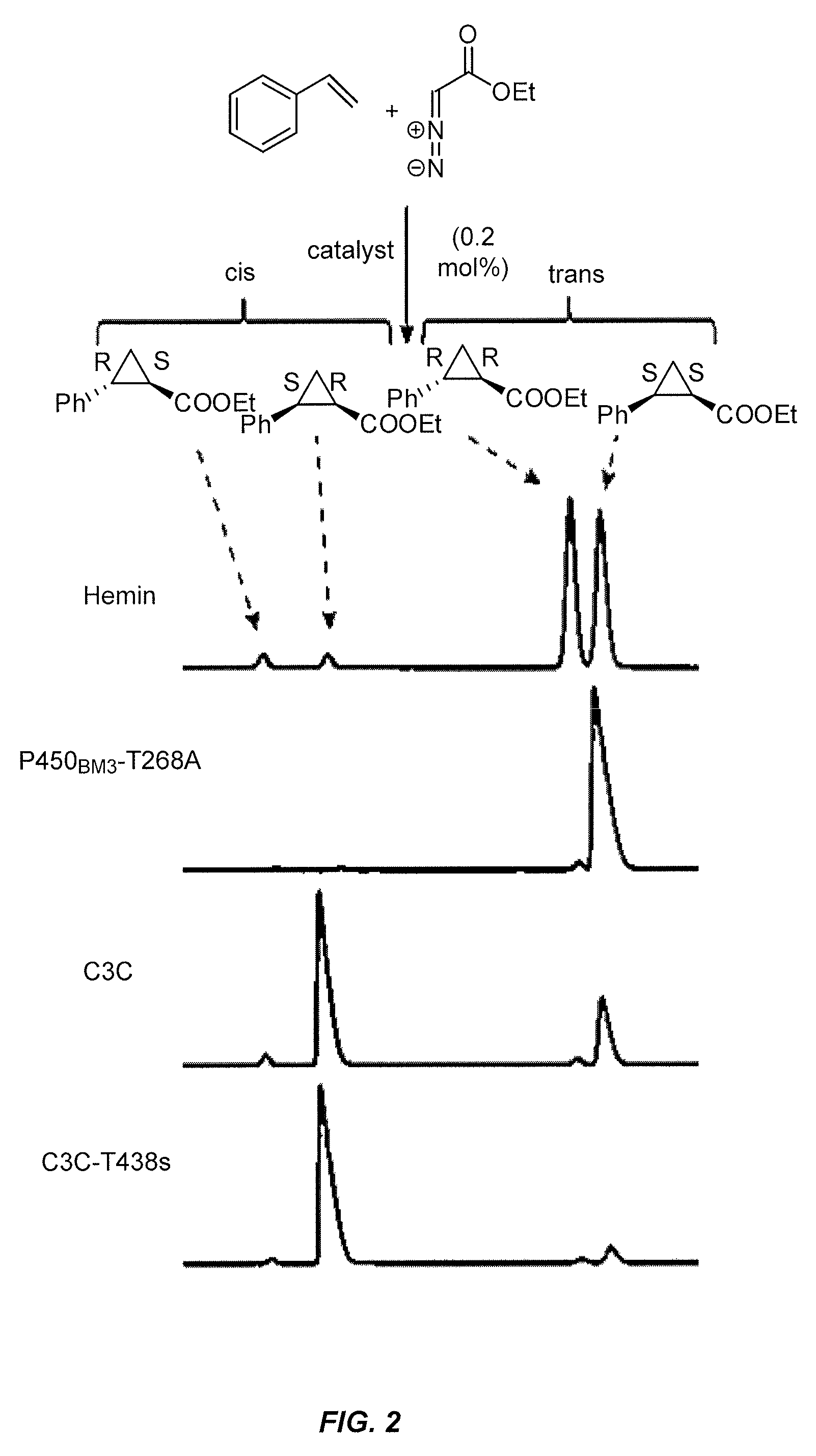In vivo and in vitro olefin cyclopropanation catalyzed by heme enzymes
a technology of heme enzymes and cyclopropane, which is applied in the field of in vivo and in vitro heme enzymes catalyzing cyclopropane, can solve the problems of high yield, difficult to achieve stereoselectivity in these systems, and direct introduction of new carbon-carbon centers into complex structures
- Summary
- Abstract
- Description
- Claims
- Application Information
AI Technical Summary
Benefits of technology
Problems solved by technology
Method used
Image
Examples
example 1
C═C Functionalization by Enzyme-Catalyzed Carbenoid Insertion
[0340]This example illustrates bacterial cytochrome P450s that are engineered to catalyze highly stereoselective carbene transfers to aryl-substituted olefins, a reaction without a known biological counterpart.
[0341]Creating enzymes that catalyze novel reactions, one of the hallmarks of evolution, is a huge challenge and nearly unexplored frontier in protein engineering. Carbene transfers to C═C bonds are powerful catalytic methods that lack biological counterparts. Stereo-control over these transformations currently relies on expensive transition metal catalysts that require toxic organic solvents and are difficult to systematically modify or optimize. This example illustrates variants of cytochrome P450BM3 that catalyze an important reaction not previously known for this monooxygenase: the cyclopropanation of styrene from diazoester reagents with exquisite enantio- and diastereocontrol. As such, this example demonstrates...
example 2
In Vivo and In Vitro Olefin Cyclopropanation Catalyzed by Heme Enzymes
[0439]This example illustrates the use of heme containing enzymes to catalyze the conversion of olefins to various products containing one or more cyclopropane functional groups. In certain aspects, this example demonstrates novel variants of cytochrome P450BM3 (CYP102A1). These variants have an improved ability to use diazo esters as carbene precursors and cyclopropanate various olefins. Preferred variants include cytochrome P450BM3 mutants having C400S and T268A amino acid substitutions and engineered variants of other P450s having the equivalent substitutions. Variants with axial serine coordination efficiently catalyze the cyclopropanation reaction in whole cells sustaining over 10,000 total turnovers.
Introduction
[0440]The many strategies for functionalizing C═C and C—H bonds that have evolved in Nature have captivated the imaginations of chemists and form the foundation of biomimetic chemistry (J. T. Groves, ...
example 3
In Vivo and In Vitro Olefin Cyclopropanation Catalyzed by Heme Enzymes
[0562]This example illustrates the use of heme containing enzymes to catalyze the conversion of olefins to various products containing one or more cyclopropane functional groups. In certain aspects, this example demonstrates novel variants of cytochrome P450BM3 (CYP102A1 or BM3) having an improved ability to catalyze the formal transfer of carbene equivalents from diazo esters to various olefins, making cyclopropane products with high stereoselectivity. Preferred variants include, but are not limited to, cytochrome P450BM3 mutants having C400S and T268A amino acid substitutions and engineered variants of other P450s having the equivalent substitutions. Axial serine heme ligation (C400S in BM3) in cytochrome P450s creates the homologous “cytochrome P411” family. Cytochrome P411s catalyze the cyclopropanation reaction in whole cells, sustaining over 10,000 total turnovers with high stereoselectivity, making the cycl...
PUM
| Property | Measurement | Unit |
|---|---|---|
| structure | aaaaa | aaaaa |
| time | aaaaa | aaaaa |
Abstract
Description
Claims
Application Information
 Login to View More
Login to View More - R&D
- Intellectual Property
- Life Sciences
- Materials
- Tech Scout
- Unparalleled Data Quality
- Higher Quality Content
- 60% Fewer Hallucinations
Browse by: Latest US Patents, China's latest patents, Technical Efficacy Thesaurus, Application Domain, Technology Topic, Popular Technical Reports.
© 2025 PatSnap. All rights reserved.Legal|Privacy policy|Modern Slavery Act Transparency Statement|Sitemap|About US| Contact US: help@patsnap.com



